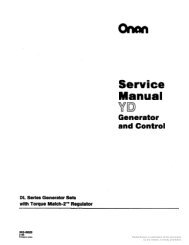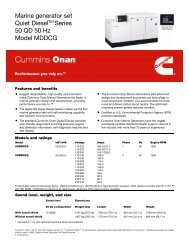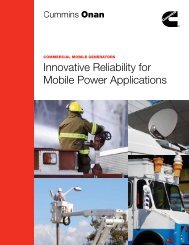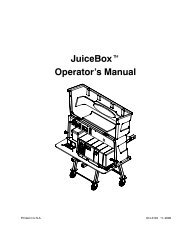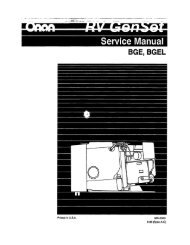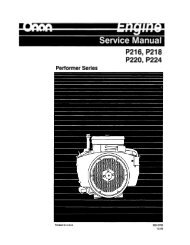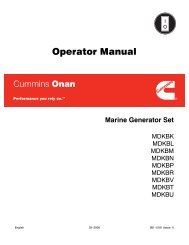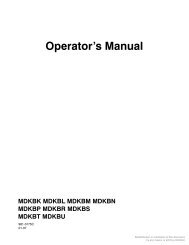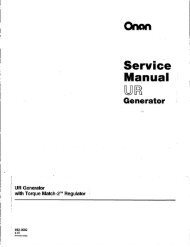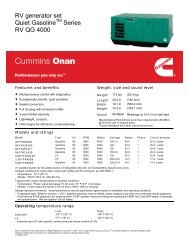Operation and Installation - Cummins Onan
Operation and Installation - Cummins Onan
Operation and Installation - Cummins Onan
Create successful ePaper yourself
Turn your PDF publications into a flip-book with our unique Google optimized e-Paper software.
<strong>Installation</strong><br />
GENSET<br />
WARNING Improper installation can result in<br />
severe personnel injury or death. The installer<br />
must be trained <strong>and</strong> experienced in the installation<br />
of electrical, mechanical <strong>and</strong> hydraulic<br />
equipment.<br />
Note: Manuals are updated from time-to-time to reflect<br />
changes in the equipment <strong>and</strong> its specifications.<br />
For this reason, only the copy of the installation<br />
manual supplied with the genset should be used<br />
as a guide for the installation.<br />
The builder of the vehicle bears sole responsibility<br />
for the selection of the appropriate genset, for its<br />
proper installation <strong>and</strong> for obtaining approvals from<br />
the authorities (if any) having jurisdiction over the<br />
installation. The genset is suitable for <strong>Installation</strong> in<br />
accordance with the National Electrical Code<br />
(NFPA No. 70) or the Canadian Electrical Code<br />
(C22.1). When properly installed it will meet the certification<br />
requirements of NFPA 1903.<br />
Before mounting the genset, pump or oil reservoir,<br />
carefully consider the routing of all hydraulic hoses<br />
<strong>and</strong> wiring.<br />
Refer to the Outline Drawings (beginning on<br />
Page A-1) regarding outside dimensions, weight,<br />
mounting bolt holes, cooling air inlet <strong>and</strong> outlet<br />
openings <strong>and</strong> hydraulic <strong>and</strong> wiring connections.<br />
Cooling Air Flow<br />
For sufficient air flow to cool the genset, provide at<br />
least 3 inches (76 mm) of clearance in front of <strong>and</strong><br />
across the entire face of the finned heat exchanger<br />
(air outlet) <strong>and</strong> in front of both air inlets. Two (2) air<br />
inlets must be open. Rearrange the plates <strong>and</strong><br />
screens, as necessary, between the four or five air<br />
inlet openings. The location with respect to bulkheads<br />
<strong>and</strong> other equipment must be such that the<br />
warm air does not recirculate back into the genset<br />
air inlets.<br />
Cooling Air Test<br />
To determine whether the installation allows for sufficient<br />
genset cooling, monitor oil temperature with<br />
the display module (Figure 1) while running the genset<br />
under full load for at least two hours. Oil temperature<br />
must not exceed 185° F (85° C). If it does,<br />
check inlet air temperature.<br />
• Inlet air temperature should not exceed ambient<br />
air temperature by more than 25° F (14° C).<br />
If it does, cooling air is recirculating between<br />
the outlet <strong>and</strong> inlets or is being heated some<br />
other way, such as by passing through the hot<br />
engine compartment. The genset must be relocated<br />
or the air inlets <strong>and</strong> outlets baffled to prevent<br />
recirculation or the entrance of hot air from<br />
another source.<br />
• If inlet air temperature exceeds ambient air<br />
temperature by less than 25° F (14° C) but oil<br />
temperature exceeds 185° F (85° C), inlet or<br />
outlet air is being blocked or restricted. The<br />
genset must be relocated or the obstructions<br />
removed.<br />
• If inlet air temperatures exceed 120° F (49° C)<br />
the genset must be derated to prevent oil temperatures<br />
from exceeding 185° F (85° C).<br />
NFPA Certification Test<br />
As oil temperature rises, hydraulic efficiency falls off<br />
slightly. Therefore, load the genset to 103-104 percent<br />
of rated load at the start of the 2-hour NFPA<br />
Certification Test. If the inlet air temperature does<br />
not exceed 120° F (49° C), the genset will finish the<br />
test carrying at least 100 percent of rated load,<br />
meeting the certification requirements. See Cooling<br />
Air Test if air temperature exceeds specifications.<br />
Hydraulic <strong>and</strong> Electric Interconnections<br />
See HYDRAULIC CONNECTIONS (Page 8) <strong>and</strong><br />
WIRING CONNECTIONS (Page 6) for important<br />
considerations with respect to interconnections between<br />
components in the system.<br />
4



